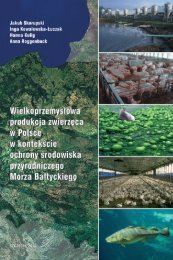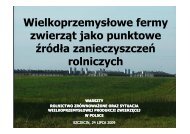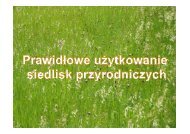best available technologies for manure treatment - Baltic Green Belt
best available technologies for manure treatment - Baltic Green Belt
best available technologies for manure treatment - Baltic Green Belt
Create successful ePaper yourself
Turn your PDF publications into a flip-book with our unique Google optimized e-Paper software.
Best Available Technologies <strong>for</strong> <strong>manure</strong> <strong>treatment</strong> baltic sea 2020<br />
1: INTRODUCTION AND BACKGROUND DESCRIPTION<br />
1: INTRODUCTION AND BACKGROUND DESCRIPTION<br />
1.1: Background<br />
Leaching of nutrients from sites with intensive<br />
rearing of livestock, also known as agricultural hot<br />
spots, has been identified by the Helsinki Commission<br />
as a prioritized area. Data shows that the amount<br />
of Phosphorous (P) and Nitrogen (N) in livestock<br />
<strong>manure</strong> spread on agricultural land by EU Member<br />
States in the <strong>Baltic</strong> Sea catchment area is 3–4 times<br />
higher than the amounts discharged from all households<br />
in the same area.<br />
Consultations have been done on the value and<br />
potential <strong>for</strong> <strong>Baltic</strong> Sea 2020 to address <strong>manure</strong><br />
handling at intensive livestock farming with e.g.<br />
HELCOM, Swedish Institute of Agricultural and Environmental<br />
Engineering (JTI), Swedish University<br />
of Agricultural Sciences (SLU), Swedish Environmental<br />
Research Institute (IVL) and the Federation <strong>for</strong><br />
Swedish Farmers (LRF). There is concordance on the<br />
importance to reduce nutrient leakage from intensive<br />
livestock farms to the <strong>Baltic</strong> Sea, through technical<br />
development and spreading of “Best Practices”.<br />
<strong>Baltic</strong> Sea 2020 has initiated a project to identify<br />
Best Available Technologies to reduce leaching of nutrients<br />
from farms with intensive rearing of pigs. The<br />
target area of the project is EU Member States of the<br />
<strong>Baltic</strong> Sea area: Sweden, Denmark, Poland, Germany,<br />
Finland, Estonia, Latvia, and Lithuania.<br />
Based on analyses of current projects and activities,<br />
existing EU legislation and with consideration<br />
to the sources of origin of N and P leaching to the<br />
<strong>Baltic</strong> Sea, the report focuses on:<br />
• Pig production in herds of more than 2.000 pigs<br />
• Technologies <strong>for</strong> <strong>manure</strong> <strong>treatment</strong> rather than<br />
practices <strong>for</strong> <strong>manure</strong> storage and spreading<br />
• Denmark and Poland’s parts of the <strong>Baltic</strong> Sea<br />
river basin area<br />
1.2: Turnover of N and P in the<br />
agricultural environment<br />
When focusing on the N and P in livestock <strong>manure</strong> it<br />
is important to clarify the process stage from animal<br />
to final disposal. Figure 1 indicates via indexes the typical<br />
retention of N and P in agricultural production<br />
systems that respect good agricultural practices – the<br />
rest is generally lost to the environment.<br />
N is lost to the environment both via emissions,<br />
leaching and run-off. Typically the emissions are<br />
relatively high in pig stables, but emissions can also<br />
happen from <strong>manure</strong> storages and in connection<br />
with spreading. Run-off happens if <strong>manure</strong> is spilled<br />
on the ground, if the floors in stables and the walls<br />
and floors of the <strong>manure</strong>s stores are not water tight,<br />
if there is a long time span between spreading of<br />
<strong>manure</strong> on the fields and the incorporation into the<br />
soil, or if livestock <strong>manure</strong> is spread on steep, frozen<br />
or water saturated soils.<br />
Nitrogen (N) leaching from livestock <strong>manure</strong>s happens<br />
especially as percolation through soil layers<br />
when it is applied on fields in an imprecise way, not<br />
being based on norms and fertiliser planning, or<br />
when it is distributed to bare soils or in any case at<br />
periods, ways and situations where the nutrients are<br />
Index of N amount: 100 80 75 50<br />
Phase:<br />
Manure leaving<br />
animal<br />
Manure leaving<br />
stable<br />
Manure leaving<br />
storage<br />
Re-circulated in the<br />
crop<br />
Index of P amount: 100 95 90 85<br />
Figure 1: Recirculation of N and P in the agricultural production, based on Poulsen & Kristensen (1998) and Birkmose<br />
et al. (2007) as concerns <strong>manure</strong> leaving animal, stable and storage, while indications <strong>for</strong> P as well as amounts<br />
re-circulated in the crop largely are own estimates in situations, where good agricultural practices are applied.<br />
10








